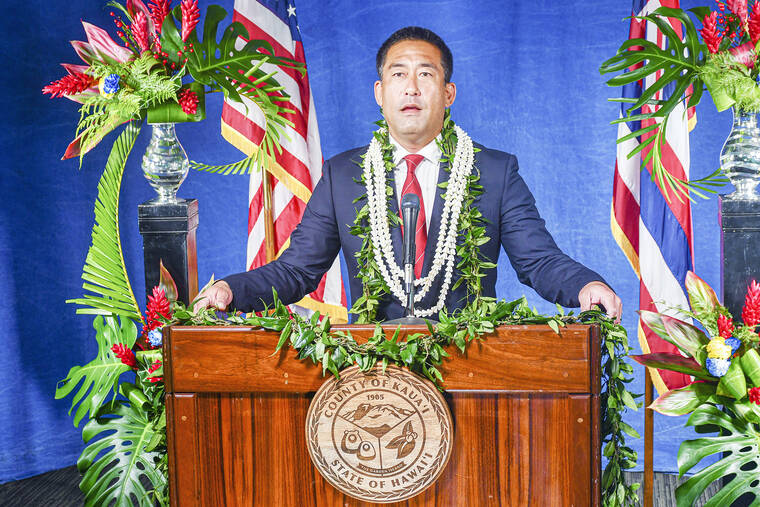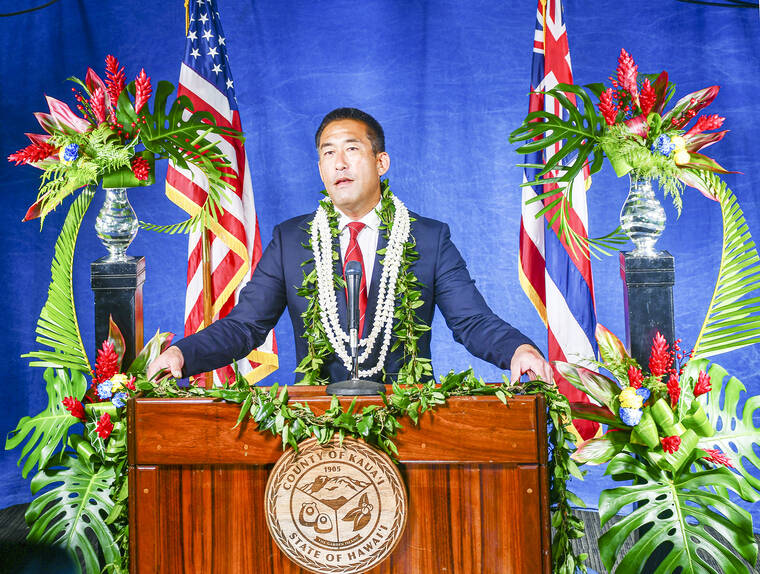LIHU‘E — Reflecting on his last three years in office, Mayor Derek Kawakami, in his fourth State of the County address on Monday, is offering a more-optimistic projection of the upcoming fiscal year and holding onto his past promises to keep the county on track with investing in services and maintenance.
“I never would have imagined the responsibility that came with this job,” Kawakami, who is running for reelection, said. “Yet, I feel so fortunate to have been called to serve during this time. I am grateful we are at a point where we can see the light of hope, and remain cautiously optimistic that the post-COVID era is just around the corner.”
With County of Kaua‘i revenues in line with pre-pandemic numbers, Kawakami proposed a $260.2 million operating budget and a $49 million capital improvement projects budget for fiscal year 2023, which will begin July 1, should it get approval from the Kaua‘i County Council.
In FY22, Kawakami proposed a $243 million operating budget and a $24.3 million CIP budget. This fiscal year ends on June 30.
About 67% of the county’s budget goes to salaries, leaving 33% for Kawakami to focus on his “tangible goals and initiatives. So it’s important, particularly during these uncertain times, that we invest our money wisely.”
Largely, over the last four years, for Kawakami that’s looked like making good on deferred-maintenance goals, upgrading county services and investing in the departments.
This upcoming year, that’ll be a little easier with more cash on hand.
“The county’s anticipated cash flow in fiscal year ‘23 provides us a small-but-opportune window to make strategic investments in our operations, as we anticipate large collective-bargaining increases in the years ahead, coupled with continued economic fluctuations,” Kawakami said.
Money will come in from the county’s freshly established Kaua‘i Transient Accommodations Tax, which at 3% will make up for what the county lost when the state repealed the law giving the counties a share of the state TAT.
Tax rates will remain flat, as real-property tax assessments have brought in over $30 million in revenue over last year.
And by refinancing outstanding general-obligation bonds, the county reduced its debt service by about $450,000.
During his time in office, Kawakami has had to dramatically reduce spending in anticipation of lesser revenues due to shutdowns in an attempt to avoid furloughs and layoffs, including planned fee increases.
By tapping into the county’s reserve fund and federal and state coronavirus aid, the county was able to fend off raising taxes or cutting staff.
Continued projects, maintenance goals
“Addressing decades of deferred maintenance is a top priority of our administration, focusing on projects that we need, and not necessarily what we want. And our budget reflects our commitment to build that foundation,” Kawakami said.
One of those needs is a new landfill site, with the Kekaha Landfill nearing its capacity and the construction of a new site not having been determined, a multi-year gap where the county has no county landfill may be on the horizon.
“As we reported to the council earlier this year, the previously elected Ma‘alo Site is not viable due to the inability to secure agreements with impacted state agencies, ” he said. “Our (Department of Public Works) Solid Waste team is now committed to working closely with the council, state and community partners to identify a new landfill location.”
Kawakami committed to working on the county’s Integrated Solid Waste Management Plan’s recommendation to study the feasibility of a materials recovery facility, curbside recycling and other waste-diversion programs.
The county will use about $4 million in Federal Transit Authority funds for The Kaua‘i Bus baseyard expansion project, as well as use about $5.3 million to invest in wastewater infrastructure to upgrade treatment plants.
“This work is necessary to help us meet regulatory standards and avoid system failures,” he said.
Last year, Kawakami reported that a survey showed the county had about $80 million in deferred-maintenance costs, which has become “increasingly” concerning to the administration. This year’s budget looks to invest over $15 million into road-resurfacing.
“We are also focused on islandwide bridge repairs and the long-awaited reconstruction of Olohena Road in Wailua, and Moi Road in Hanapepe,” he said. “We thank our partners at the state (Department of Transportation) for supporting these projects through the Statewide Transportation Improvement Program.”
Housing, parks
“Investing and caring for our communities means caring for everyone, keiki to kupuna. That starts with ensuring our residents have safe shelter,” Kawakami said. “It is no secret that we are tackling a housing crisis in Hawai‘i. We are in a race to create affordable-housing opportunities for our local residents.”
Kawakami pointed to Pua Loke in Lihu‘e, which provides 54 affordable apartments. Across the street, the county has its first transitional housing project, Kealaula, which also provides outreach services.
Recreating this model, the county is working on Kealaula at Lima Ola in ‘Ele‘ele, which will provide 85 units, including 40 dedicated to kupuna.
A new development on 50 acres in Kilauea will bring affordable housing to the North Shore.
About $2.5 million in CIP funds will be used to improve existing playgrounds and facilities.
The county is heading into the final phase of the construction of the Ke Ala Hele Makalae in Kapa‘a.
Kawakami is proposing relocating personnel and establishing two new park rangers, with one at the Kapa‘a coastal path and Bryan J. Baptiste Sports Complex.
Once this path is done, the county will begin work on a shared-use path on the Westside.
The administration is also looking to create a Lihu‘e Town Core Beautification Crew, dedicating three staff members and equipment to maintain the area, which includes the Kaua‘i War Memorial Convention Hall and civic center.
“This will allow our existing beautification crews to devote more attention to areas such as the Kapa‘a boardwalk and county cemeteries across the island,” Kawakami said.
Tourism
Working with state and county partners, Kawakami touted the work achieved by the implementation of the county’s Tourism Strategic Plan and the Hawai‘i Tourism Authority’s Destination Management Action Plan.
“We have heard the calls for our leaders across the state to strike a balance between our economic reliance on the visitor industry and the visitor industry’s reliance on our limited resources,” Kawakami said.
Kawakami pointed to the county’s Office of Economic Development’s partnership with HTA and the Kaua‘i Visitors Bureau to create more access for residents and visitors to get around the island, with different access points for shuttles, car shares and bicycles.
And to produce revenue while reducing overcrowding, a paid-parking program for visitors at county-owned Lydgate, Po‘ipu and Black Pot beach parks is in the works.
What’s next?
Kawakami will formally submit the budget to the council Tuesday, with its budget message.
Council will review budgets with departments, asking questions of the administration over the course of the next few months. In May, the mayor and his office will submit a supplemental budget that may look drastically different, as more projections and revenue numbers become more concrete.
Correction: This story was updated to clarify a Kilauea affordable housing development project.
It is a 23 acre property that is currently behng acquired through eminent domain for housing, not a 50 acre parcel.
•••
Sabrina Bodon, editor, can be reached at 245-0441 or sbodon@thegardenisland.com.



